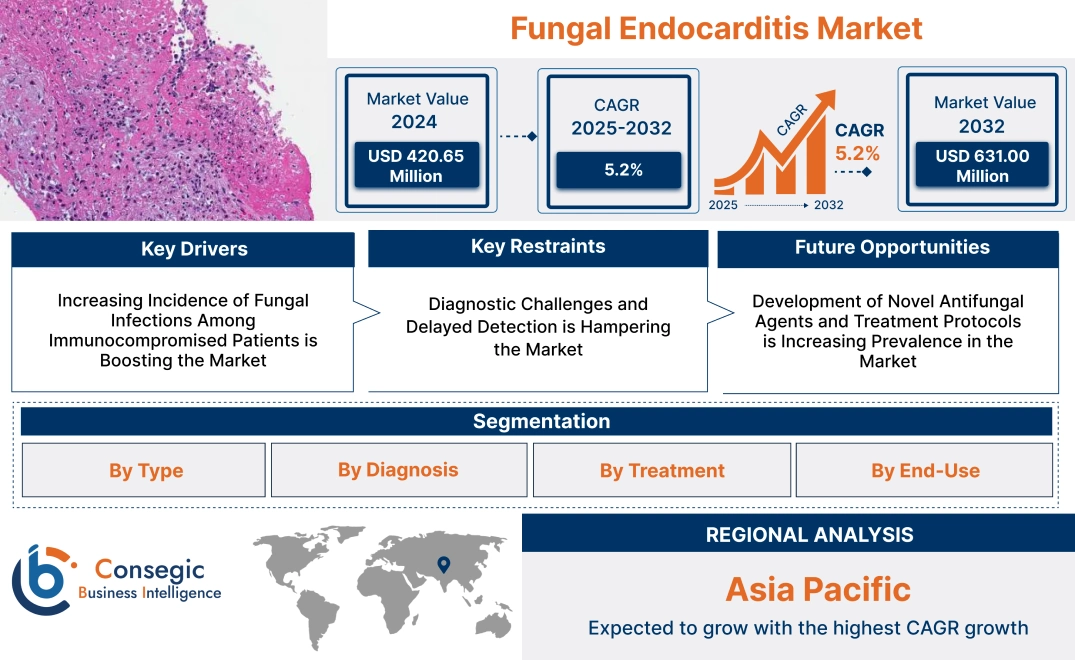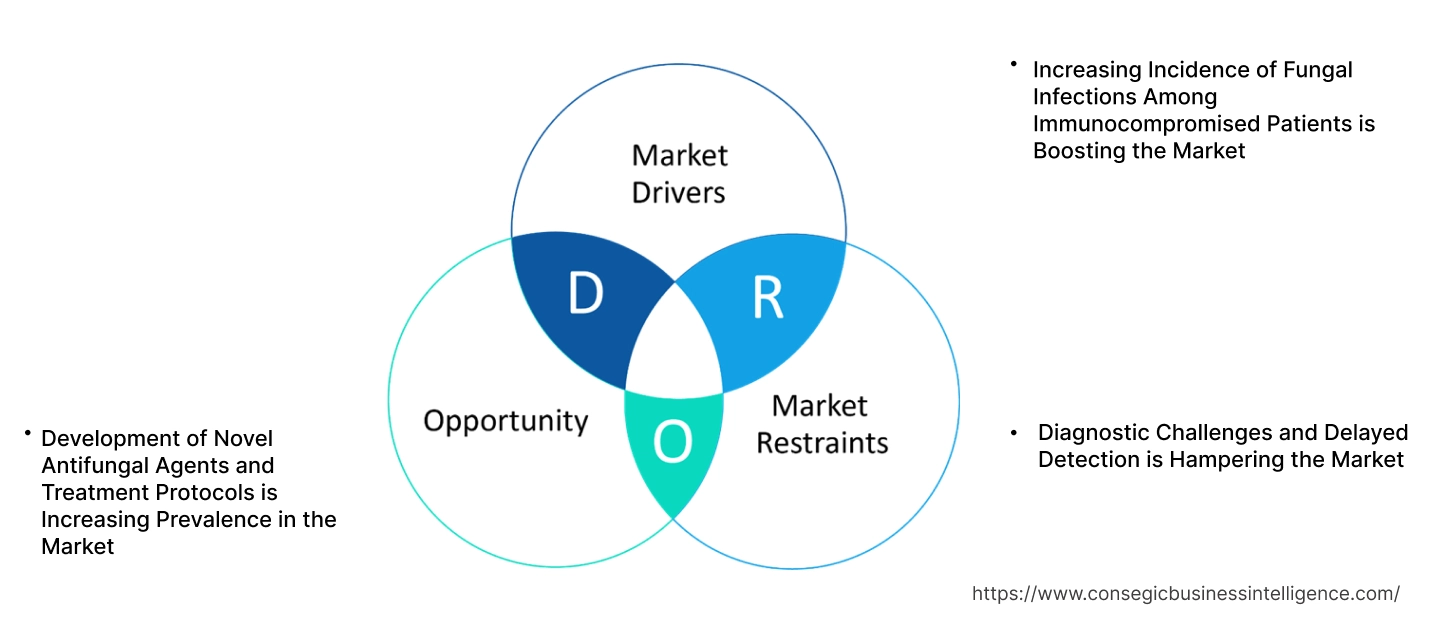Fungal Endocarditis Market Size:
Fungal Endocarditis Market size is estimated to reach over USD 631.00 Million by 2032 from a value of USD 420.65 Million in 2024 and is projected to grow by USD 435.03 Million in 2025, growing at a CAGR of 5.2%from 2025 to 2032.
Fungal Endocarditis Market Scope & Overview:
The fungal endocarditis performs diagnosis, treatment, and management of fungal infections of the heart's inner lining or valves, a rare but severe condition often caused by Candida and Aspergillus species. The market encompasses antifungal drugs, diagnostic tools, and surgical interventions aimed at addressing this life-threatening condition. Key characteristics of fungal endocarditis treatments include high efficacy, ability to penetrate biofilms, and compatibility with surgical procedures such as valve replacement. The benefits include improved survival rates, effective infection control, and enhanced recovery in patients with compromised immune systems. Applications span hospitals, specialty clinics, and diagnostic laboratories, where rapid diagnosis and targeted therapies are critical. End-users include healthcare providers, cardiology specialists, and infectious disease experts, driven by the increasing prevalence of immunocompromised conditions, advancements in antifungal therapies, and growing awareness of early diagnosis and treatment of fungal endocarditis.
Fungal Endocarditis Market Dynamics - (DRO) :
Key Drivers:
Increasing Incidence of Fungal Infections Among Immunocompromised Patients is Boosting the Market
The prevalence of fungal infections, particularly among immunocompromised individuals, has seen a significant rise due to increasing cases of cancer, organ transplantation, HIV/AIDS, and long-term use of immunosuppressive drugs. Fungal endocarditis, a severe manifestation of invasive fungal infections, poses a critical health risk in this population. Its association with medical interventions such as central venous catheters and prosthetic heart valves further highlights the susceptibility of immunocompromised patients.
Trends in managing complex medical conditions underscore the importance of effective diagnosis and treatment options for fungal endocarditis. Analysis indicates that the growing awareness and focus on infection control are driving the integration of advanced tools and therapies to address this critical healthcare challenge.
Key Restraints:
Diagnostic Challenges and Delayed Detection is Hampering the Market
Fungal endocarditis often presents with non-specific symptoms, making it difficult to diagnose promptly. Traditional diagnostic methods, such as blood cultures, have limited sensitivity and can delay definitive detection, leading to disease progression and poor clinical outcomes. The need for advanced diagnostic techniques, such as molecular assays and imaging technologies, is critical to overcoming these limitations.
Trends in precision diagnostics and early intervention strategies highlight the importance of accurate and rapid detection tools. However, their high cost and limited availability in resource-constrained settings remain significant barriers, emphasizing the need for scalable and accessible diagnostic solutions.
Future Opportunities :
Development of Novel Antifungal Agents and Treatment Protocols is Increasing Prevalence in the Market
The increasing resistance to existing antifungal therapies and the toxicity associated with current treatments, such as amphotericin B and azoles, are driving the development of novel antifungal agents. Innovative therapies, including combination treatments and targeted antifungal drugs, aim to address these gaps by improving efficacy while minimizing side effects. These advancements are particularly crucial for managing severe cases of fungal endocarditis that require aggressive treatment.
Trends in pharmaceutical research and development are aligning with the demand for safer and more effective antifungal solutions. The analysis highlights that ongoing innovations in drug formulations and treatment protocols present a significant opportunity to improve patient outcomes and address unmet needs in the management of fungal endocarditis.
Fungal Endocarditis Market Segmental Analysis :
By Type:
Based on type, the market is segmented into Candida endocarditis, Aspergillus endocarditis, Histoplasma endocarditis, and others.
The Candida endocarditis segment accounted for the largest revenue in 48.60% share in 2024.
- Candida endocarditis is the most common type of fungal endocarditis, primarily affecting patients with compromised immune systems or those with implanted cardiac devices.
- The rising prevalence of Candida infections in hospital settings, particularly among patients undergoing prolonged antibiotic therapy or invasive procedures, has driven the fungal endocarditis market trends for targeted diagnostics and treatments.
- Increasing awareness and advancements in antifungal medications, such as echinocandins and azoles, have further supported the dominance of this segment.
- The analysis shows growing use of echocardiography and PCR tests for accurate and early diagnosis of Candida infections has boosted its treatment rates.
The Aspergillus endocarditis segment is anticipated to register the fastest CAGR during the forecast period.
- Aspergillus endocarditis is less common but often presents with severe complications, requiring prompt and aggressive treatment.
- The increasing incidence of invasive Aspergillus infections, particularly in immunocompromised patients, has heightened the need for advanced diagnostic and therapeutic solutions.
- The growing adoption of polymerase chain reaction (PCR) tests and serology tests for rapid identification of Aspergillus species is driving fungal endocarditis market growth in this segment.
- Rising research efforts and clinical trials focusing on effective antifungal therapies for Aspergillus infections are expected to propel fungal endocarditis market opportunities.
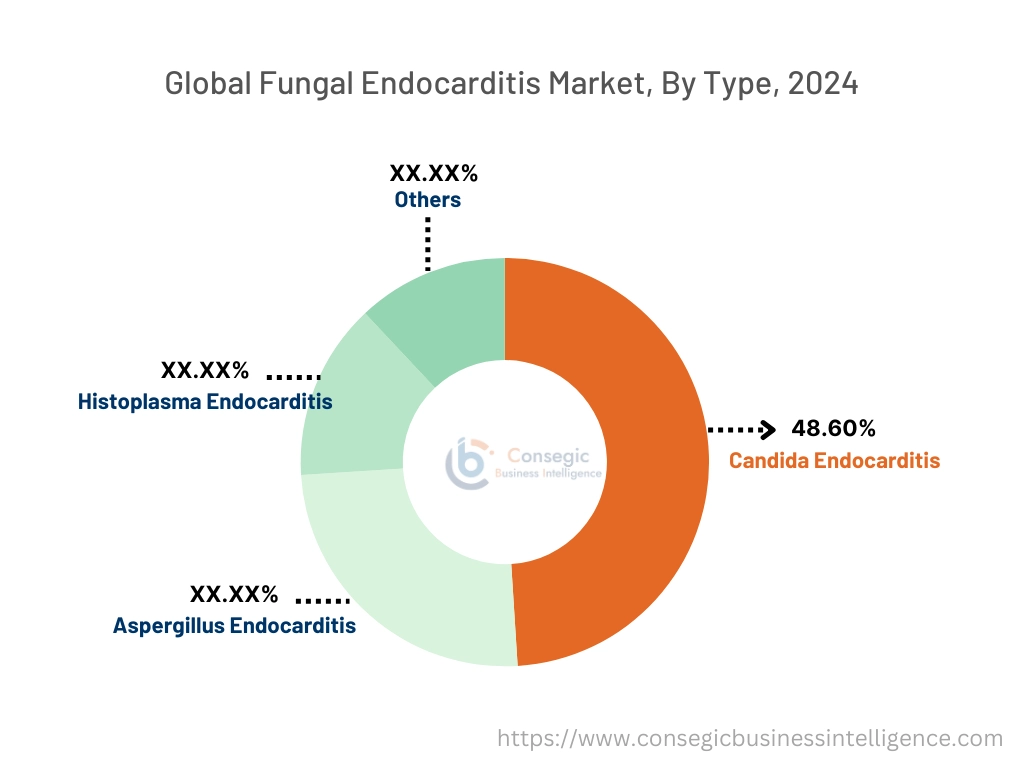
By Diagnosis:
Based on diagnosis, the market is segmented into blood cultures, echocardiography, polymerase chain reaction (PCR) tests, serology tests, and others.
The blood cultures segment accounted for the largest revenue of fungal endocarditis market share in 2024.
- Blood cultures are considered the gold standard for diagnosing fungal endocarditis, providing reliable results for the identification of fungal pathogens.
- The widespread availability of blood culture techniques and their routine use in hospitals and clinical laboratories have driven their adoption.
- Advancements in automated blood culture systems have enhanced the speed and accuracy of detecting fungal infections, further supporting this segment’s dominance.
- The increasing prevalence of systemic fungal infections and the emphasis on early and accurate diagnosis are fueling the trends for blood culture diagnostics.
The PCR tests segment is anticipated to register the fastest CAGR during the forecast period.
- PCR tests offer rapid and precise identification of fungal DNA, enabling early diagnosis and timely initiation of treatment.
- The growing adoption of molecular diagnostic techniques in hospitals and research institutes is driving the fungal endocarditis market trends for PCR-based fungal detection.
- Rising awareness about the benefits of PCR tests, including their ability to detect low-level fungal infections, is supporting fungal endocarditis market growth.
- Continuous advancements in PCR technology, such as real-time and multiplex PCR, are expected to further boost adoption rates in clinical and diagnostic settings.
By Treatment:
Based on treatment, the market is segmented into antifungal medications, surgical intervention, and combination therapy.
The antifungal medications segment accounted for the largest revenue share in 2024.
- Antifungal medications, including amphotericin B, azoles, and echinocandins, are the cornerstone of fungal endocarditis treatment, offering targeted action against fungal pathogens.
- Amphotericin B remains a critical option for severe fungal infections, while azoles and echinocandins are increasingly used for less invasive cases due to their improved safety profiles.
- The growing prevalence of fungal infections and the rising availability of advanced antifungal drugs in hospitals and specialty clinics have driven this segment’s advancement.
- Increased research and development efforts to enhance antifungal drug efficacy and reduce side effects are further supporting the segment's expansion.
The combination therapy segment is anticipated to register the fastest CAGR during the forecast period.
- Combination therapy, involving antifungal medications and surgical intervention, is increasingly used to manage complex cases of fungal endocarditis.
- This approach is particularly effective in treating infections involving prosthetic valves or extensive fungal growth.
- The rising adoption of combination therapy in hospitals and ambulatory surgical centers, supported by growing evidence of its efficacy, is driving trends.
- Increased clinical trials and advancements in surgical techniques are expected to further enhance the adoption of combination therapies.
By End-User:
Based on end-use, the market is segmented into hospitals, specialty clinics, ambulatory surgical centers, and research institutes.
The hospitals segment accounted for the largest revenue of fungal endocarditis market share in 2024.
- Hospitals are the primary treatment centers for fungal endocarditis, managing high volumes of complex cases requiring specialized care and advanced diagnostics.
- The availability of skilled healthcare professionals and advanced diagnostic tools, such as echocardiography and PCR tests, has strengthened hospitals’ position in the market.
- The rising prevalence of fungal infections among hospitalized patients, particularly those in intensive care units, has further driven trends for hospital-based care.
- Increased funding for hospital infrastructure and access to comprehensive treatment options are supporting segment growth.
The specialty clinics segment is anticipated to register the fastest CAGR during the forecast period.
- Specialty clinics focusing on infectious diseases and cardiology are increasingly adopting advanced diagnostic and treatment options for fungal endocarditis.
- The rising preference for outpatient care and targeted therapies in specialty clinics is driving advancement in this segment.
- Increased collaboration between specialty clinics and research institutes for clinical trials and advanced treatment development is supporting fungal endocarditis market expansion.
- The growing availability of portable diagnostic tools and minimally invasive treatment options in specialty clinics is expected to boost fungal endocarditis market demand further.
Regional Analysis:
The regions covered are North America, Europe, Asia Pacific, the Middle East and Africa, and Latin America.
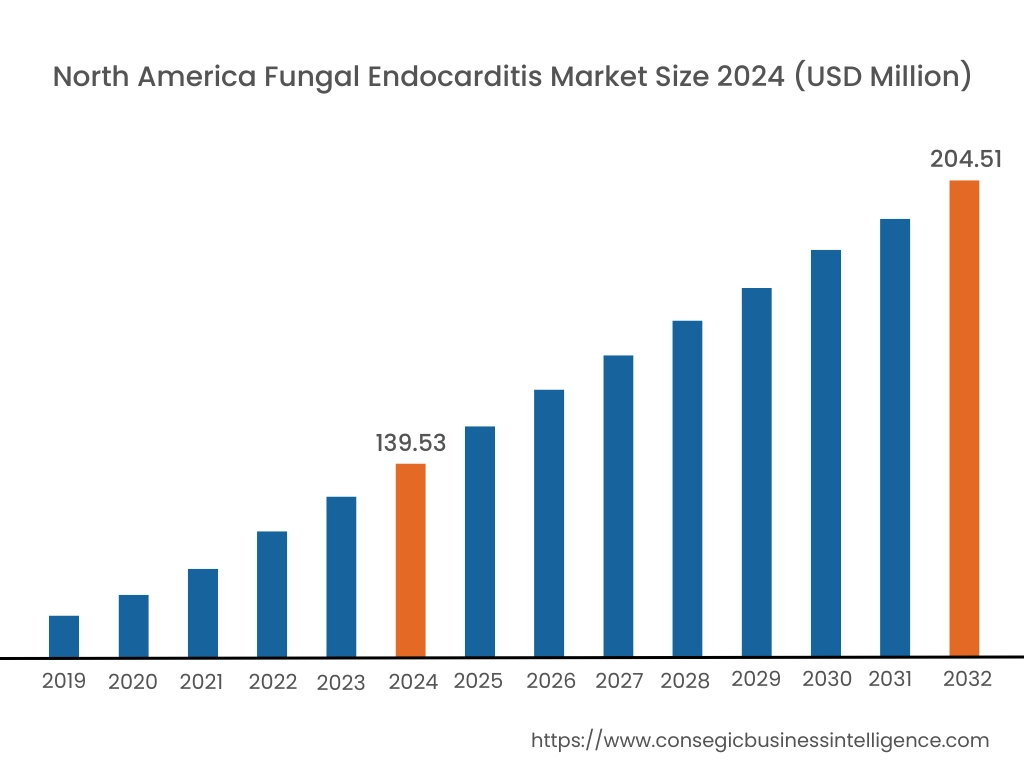
In 2024, North America was valued at USD 139.53 Million and is expected to reach USD 204.51 Million in 2032. In North America, the U.S. accounted for the highest share of 70.80% during the base year of 2024. North America holds a significant share of the fungal endocarditis market, driven by advanced healthcare infrastructure, high prevalence of fungal infections, and increasing awareness about the condition. The U.S. leads the region with strong demand for diagnostic tools, antifungal therapies, and surgical interventions to treat fungal endocarditis, particularly in immunocompromised patients. As per the fungal endocarditis market analysis, Canada contributes with its growing focus on infectious disease management and increasing use of advanced antifungal treatments. However, the high cost of treatment and diagnostic procedures may limit access for some patient groups.
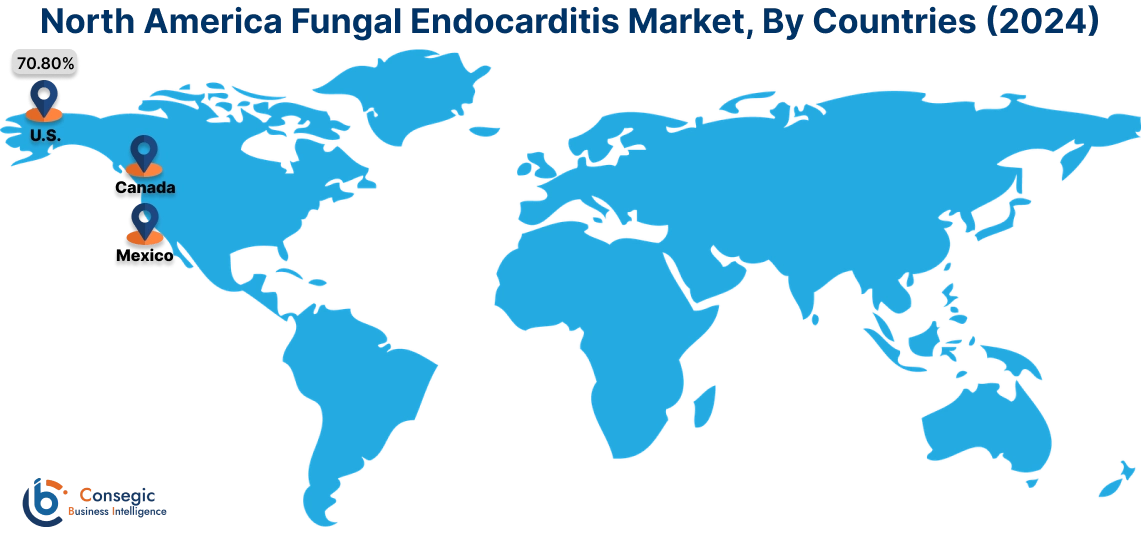
In Asia Pacific, the market is experiencing the fastest growth with a CAGR of 5.6% over the forecast period. The fungal endocarditis market is fueled by increasing healthcare investments, the rising prevalence of fungal infections, and growing awareness about infectious diseases in China, India, and Japan. China dominates the region with its expanding healthcare infrastructure and increasing focus on early diagnosis and treatment of fungal infections. India’s growing population and prevalence of immunocompromised conditions, such as diabetes and HIV, drive demand for antifungal therapies. Japan emphasizes advanced diagnostic tools and innovative therapies for fungal endocarditis. However, limited access to specialized healthcare facilities in rural areas and affordability challenges may hinder growth in some countries.
Europe is a prominent market for fungal endocarditis, supported by rising cases of fungal infections, an aging population, and well-established healthcare systems. Countries like Germany, France, and the UK are key contributors. Germany drives fungal endocarditis market demand through its advanced diagnostic facilities and access to a wide range of antifungal therapies. France focuses on treating fungal endocarditis in high-risk populations, including those undergoing cardiac surgeries. The UK emphasizes improving awareness and early detection through public health campaigns. However, stringent healthcare regulations and high treatment costs may challenge market expansion in some parts of the region.
The Middle East & Africa region is witnessing steady growth in the global fungal endocarditis market, driven by increasing healthcare investments and a rising burden of infectious diseases. Countries like Saudi Arabia and the UAE are adopting advanced diagnostic technologies and antifungal treatments to manage fungal endocarditis in hospitals and specialized clinics. In Africa, South Africa is emerging as a key market, leveraging government initiatives and international collaborations to improve access to diagnostic and treatment options for fungal infections. However, limited healthcare infrastructure in certain parts of the region may restrict market development.
Latin America is an emerging market for fungal endocarditis, with Brazil and Mexico leading the region. Brazil’s expanding healthcare sector and increasing cases of fungal infections among immunocompromised patients drive trends for advanced diagnostic tools and antifungal therapies. As per the analysis, Mexico focuses on improving access to treatment and raising awareness about fungal endocarditis in healthcare settings. The region is also seeing growing investments in research and public health initiatives to address fungal infections. However, economic instability and inconsistent healthcare policies may pose challenges to market growth in smaller economies.
Top Key Players and Market Share Insights:
The fungal endocarditis market is highly competitive with major players providing products to the national and international markets. Key players are adopting several strategies in research and development (R&D), product innovation, and end-user launches to hold a strong position in the fungal endocarditis market. Key players in the fungal endocarditis industry include -
- Pfizer Inc. (USA)
- Merck & Co., Inc. (USA)
- Astellas Pharma Inc. (Japan)
- Gilead Sciences, Inc. (USA)
- Glenmark Pharmaceuticals Ltd. (India)
- Novartis AG (Switzerland)
- GlaxoSmithKline plc (UK)
- Sanofi S.A. (France)
- Bayer AG (Germany)
- Abbott Laboratories (USA)
Recent Industry Developments :
Clinical Trials:
Fungal Endocarditis Market Report Insights :
| Report Attributes | Report Details |
| Study Timeline | 2019-2032 |
| Market Size in 2032 | USD 631.00 Million |
| CAGR (2025-2032) | 5.2% |
| By Type |
|
| By Diagnosis |
|
| By Treatment |
|
| By End-Use |
|
| By Region |
|
| Key Players |
|
| North America | U.S. Canada Mexico |
| Europe | U.K. Germany France Spain Italy Russia Benelux Rest of Europe |
| APAC | China South Korea Japan India Australia ASEAN Rest of Asia-Pacific |
| Middle East and Africa | GCC Turkey South Africa Rest of MEA |
| LATAM | Brazil Argentina Chile Rest of LATAM |
| Report Coverage |
|
